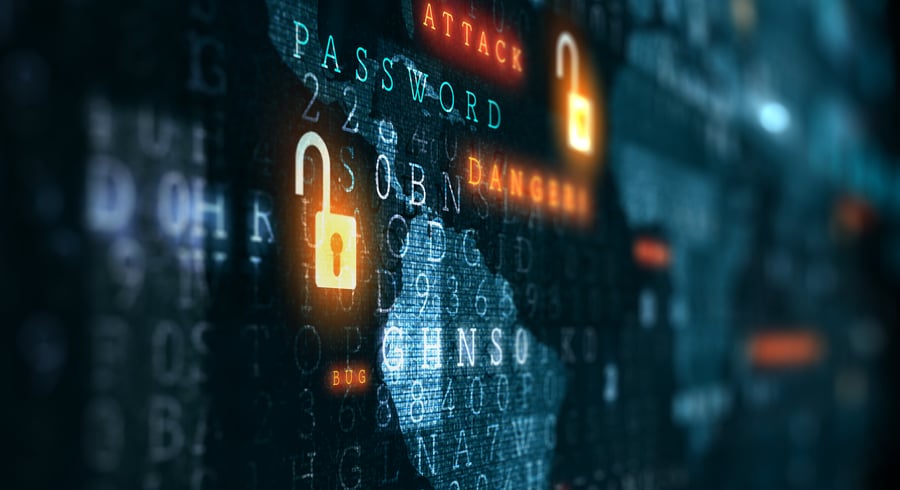5 min read
Invest in Cyber Attack Prevention: How Cybersecurity Costs Save Money
By:
Kali Mogg
on
December 15, 2021
Updated: December 16, 2021

Businesses today are operating multiple locations, connected to cloud platforms, and running smart office technology, making data and information security more essential than ever before. But complex IT environments, infrastructure, and application workloads run can require costly, time-consuming, and complicated cybersecurity measures.
However, despite the costs involved, cyber threat detection and vulnerability management are always worthwhile investments for your business. Learn why investing in your cybersecurity framework, data protection, and incident response can help prevent costly cyber attacks and lead to long-term cost savings for your business.
Security maintenance prevents costly attacks and lowers long-term costs
Depending on company size, industry, and the type of data they are protecting, businesses can spend hundreds of thousands on cyber security if not millions in a single year.

Long-term costs of a data breach
According to IBM’s 2021 Cost of a Data Breach report, the costs of system intrusions are only increasing — data breaches reached their highest average cost in the last 17 years, from $3.86 million in 2020 to $4.24 million in 2021.
When an organization experiences a system or data breach, there are various consequences and associated costs involved, including:
- Financial loss due to monetary or intellectual property (IP) theft.
- Staff costs of remediation and system repair.
- Regulatory and compliance fines.
- Increased insurance premiums.
- Legal fees due to litigation and other legal proceedings.
- Costs incurred paying for identity monitoring and credit report monitoring for affected parties.
Not only do they have to spend money on staff time for incident response (including threat detection, assessment, patching, and remediation), but they also can have long-term legal and reputational consequences.
Indirect costs can include:
- Damage to company brand and reputation (which can take years to recover).
- Public relations fees to respond to news coverage and customer responses.
- Revenue decreases due to losing existing or future contracts.
- Operational costs and lost revenue due to business disruption and IT infrastructure downtime.
How to budget for cybersecurity costs
Budgeting for cybersecurity costs can be challenging, even for business leaders in large, multinational organizations with plenty of in-house security expertise.
According to industry survey results from PwC, over half of technology and security executives are planning increasing cybersecurity spend in 2022. However, the same percentage “lack confidence that cyber spending is aligned to the most significant risks.”
When planning cybersecurity budgets, businesses need to consider numerous factors:
- What kinds of data, digital products, applications, or connected devices do they need to protect?
- What are the most common cybersecurity risks for their industry?
- Can they afford in-house IT staff? If so, what positions or skills are the highest priority?
- What kinds of IT environments do they need to secure (e.g., on-premises services, public cloud, private cloud)?
.png?width=757&name=Copy%20of%20United%20MechanicalDonahue%20%20-%20Highlighted%20Text%20Template%20(1).png)
And while you’ll need to budget for cyber attack prevention, you’ll also need money in reserve in case your business does suffer a data breach.
Generally, companies need to budget for three key areas.
Human Error and Poor Security Habits
People are often the source of major security breaches. Social engineering or phishing attacks are a common way to gain unauthorized access to protect systems, and training your non-technical and IT staff proper habits is an important part of your cybersecurity strategy.
Processes
Your business should have security risk assessment, business continuity, and incident response procedures and protocols in place to minimize downtime in the event a breach occurs and quickly establish what needs to be patched and remediated.
Technology
Your IT solutions, infrastructure, and network endpoints should all work together to support regular scanning and testing to ensure you are not leaving your systems vulnerable to common cyber attacks.
How to prioritize cybersecurity services to stay in budget
No organization can have perfect cyber security — determining your budget will require weighing the cost and benefit. You need to consider the tradeoffs of prioritizing one security measure over another so that you can stay on budget and scale your IT capabilities as you grow.
Choosing the cybersecurity products and solutions that protect your systems often depends on the specific IT environments and infrastructure that you operate.
.png?width=757&name=Copy%20of%20United%20MechanicalDonahue%20%20-%20Highlighted%20Text%20Template%20(2).png)
On the other hand, the cybersecurity services businesses choose can vary greatly, allowing you to prioritize certain capabilities over others in your budget. Make sure you prioritize essential preventative cybersecurity services such as:
- Vulnerability management.
- Compliance auditing.
- Monitoring services.
- Incident response.
- Business continuity planning.
Other cybersecurity services — such as penetration testing and security architecture assessments — can be valuable. However, they will help more with long-term cybersecurity strategy rather than your business’s immediate operational needs.
In particular, vulnerability management and monitoring services can help you pinpoint and prioritize vulnerabilities that penetration testing and security architecture assessments can further define. This will allow you to plan future cybersecurity spend when you have more funds to invest in these areas while focusing your existing budget on what needs to be addressed today.
Weighing the cost vs benefit of working with a cybersecurity service provider
Working with a cybersecurity service provider can help make your cybersecurity capabilities updated, scalable, and cost-effective. It’s important to have in-house security expertise and planning capabilities when possible.
However, maintaining the staff needed to cover network security, application security, incident response, business continuity planning, and other cybersecurity areas can be time-consuming and costly, especially if you run a small business in a high cost of living area or an area with a limited pool of IT professionals. Managed IT services can support a long-term approach to cybersecurity processes, solutions, and training.
Costs of incorporating cybersecurity into small and mid-size businesses
Self-hosted cybersecurity solutions and self-managed cybersecurity services can be cost-prohibitive, especially for small and mid-size businesses. Traditional approaches to in-house cybersecurity often come with high capital expenditure (CapEx) costs.
Raising those funds can make it difficult for small and mid-size businesses to flexibly shift their IT capabilities and adapt to changing industry requirements and customer demands.
.png?width=757&name=Copy%20of%20United%20MechanicalDonahue%20%20-%20Highlighted%20Text%20Template%20(3).png)
Businesses can spend up to 20% of the IT budget on cybersecurity alone, and managed cybersecurity services can help those funds go further and fund improved security capabilities. And converting CaPex to operational expenditures (OpEx) can help make monthly and annual expenses more predictable, giving small and mid-size businesses financial breathing room to plan and adjust their priorities as needed.
Rely on Standley Systems for cybersecurity support that fits your business needs
Standley Systems has the cybersecurity expertise and industry experience to provide the network security, monitoring, and vulnerability management services your business needs. Our team has helped businesses in Oklahoma and beyond to scale their services, secure their cloud environments, and implement business continuity planning that helps them safeguard their business operations and systems
Contact us today to learn how our managed cybersecurity services can support your business.

 800-522-3725
800-522-3725 info@standleys.com
info@standleys.com Support
Support











